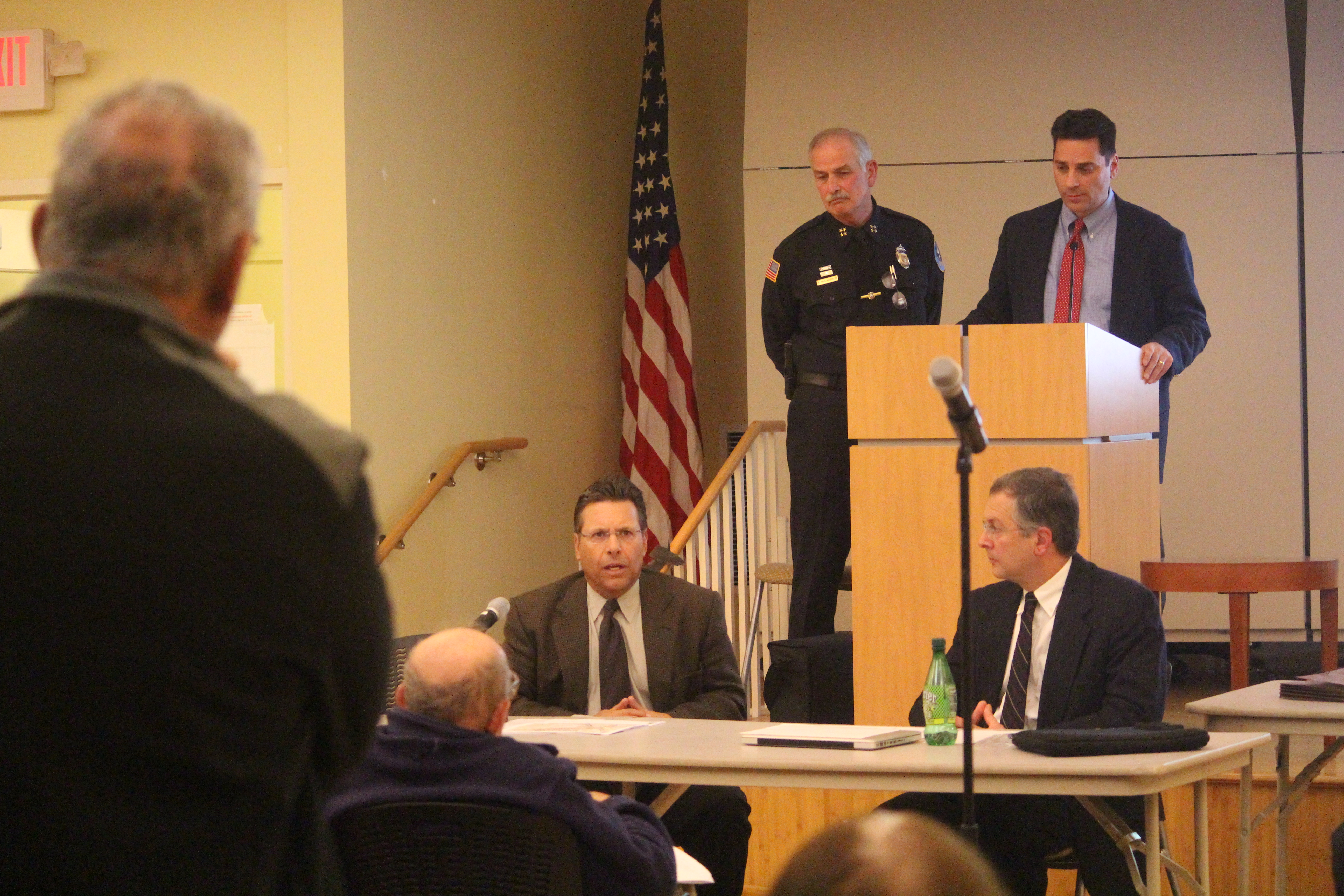After town officials gave a lengthy, detailed explanation of the financing and work proposed for the $2.8 million Belmont Center reconstruction project, Town Meeting Member Ed Kuzanjian came to the microphone and asked the assembled officials at the Nov. 6 warrant briefing held at the Beech Street Center one question.
Why?
“What are we getting for the money?” queried the School Street resident at the meeting hosted by the Warrant Committee and the Belmont League of Women Voters.
“Convince me to spend $3 million … here when we don’t put in curbs, we don’t do sidewalks and we don’t do other things around town?” said the long-serving Precinct 6 member.
The reconstruction project – which will be the sole major article before the approximate 290 members at the Special Town Meeting on Monday, Nov. 17 at the Chenery Middle School – was not just question on why its being done now but for its funding which is precedent setting new approach to financing capital projects.
For town officials, the need for the project – read the project’s highlights here – is quickly evident just by walking down the center’s main drag, Leonard Street, and the side streets. Narrow sidewalks, haphazard traffic patterns, a limited amount of pedestrian amenities and real safety concerns for walkers and cyclists have bedeviled residents and business owners for the past two, if not three, decades.
With its “tired look,” it’s little wonder several officials called the project a “facelift” for the town’s main retail business hub.
With the completion last year of the Center’s water and gas infrastructure and the new road work being completed in the town’s other two business locations of Waverley and Cushing squares, “[t]his seemed like the time to talk about Belmont Center,” Glenn Clancy, the director of the Office of Community Development and the town’s engineer,
Clancy told the audience the alternative to the project would be a simple a layer of asphalt – which would cost $900,000 – on the roadway.
But after that, “we will not talk about the center for another 20 to 25 years,” said Clancy.
With the improvements – wider sidewalks, a creation of a new “common” in front of Belmont Savings Bank, a bike path, improvements to streets that allows for a more natural flow of traffic and a modern parking program – will make “Belmont Center an attractive destination point; it is the main commercial area of Belmont,” said Clancy.
With the landlord of the former Macy’s site preparing to seek tenants for the landmark location, “there is an economic redevelopment component to revitalizing Belmont Center. If I was opening a business and I had a choice of a location that is sketchy in its presentation or go someplace that recently had a facelift and everything looks really nice, I’m going to the nice location,” said Clancy.
When Kuzanjian asked if businesses have commented on the reconstruction, Belmont Board of Selectman Chair Andy Rojas said the entire package of upgrades “add up to a better business climate.”
“Every business owner I’ve spoken to, that understands what the … finished project will look like is in favor of it,” said Rojas.
Kuzanjian countered that current studies of vehicle patterns show that there will be “minimal, if any improvement” on center traffic at the project’s completion, which town officials did not dispute.
“We don’t gain anything by doing [the project],” said Kuzanjian. “I don’t see any huge plus that’s worth three million bucks.”
“My question is why this year? Do we have the money so next year we aren’t screaming and yelling at Town Meeting that the School Department is going down the tubes again?” said Kuzanjian.
David Kale. Belmont’s Town Administrator, told Kuzanjian and the audience that all the Selectmen are asking the Special Town Meeting is whether they would like to continue with the project – which has been on the drawing boards since 2010 – “based upon all the benefits that have been outlined and finance it … from free cash.”
The project’s financing – read about the unique way the town will pay for project here – which relies on the town’s “free cash” account also came under a series of questions.
Before the meeting, the town’s free cash account was certified by the state’s Department of Revenue at $7.465 million, an increase of $1.3 million from the previous year’s amount, which Kale described as “very good news.”
“I’m a little concerned about dipping into free cash,” said Lewis Road’s Penny Shaffer, remembering previous Town Meetings where the members were told to “carefully husband [it].”
“[Town Meeting has] gotten into the habit, which I support, of taking some of the free cash and putting it into the operating budget,” said the Precinct 7 member. “But I am concerned on spending free cash on [a capital project]. Why aren’t we bonding the entire amount?”
“Is it because we are feeling so rich?” said Shaffer.
Town officials pointed to the need to strike a balance to use the town’s savings, which has been increasing over the past few years through very conservative budgeting practices, and then bonding a smaller portion of the project.
Kale said if the entire project was bonded, the town would pay $320,000 allocation the first year, as opposed to the $168,000 the first year by bonding $1,475,000 under the current proposal.








Leave a Review or Comment